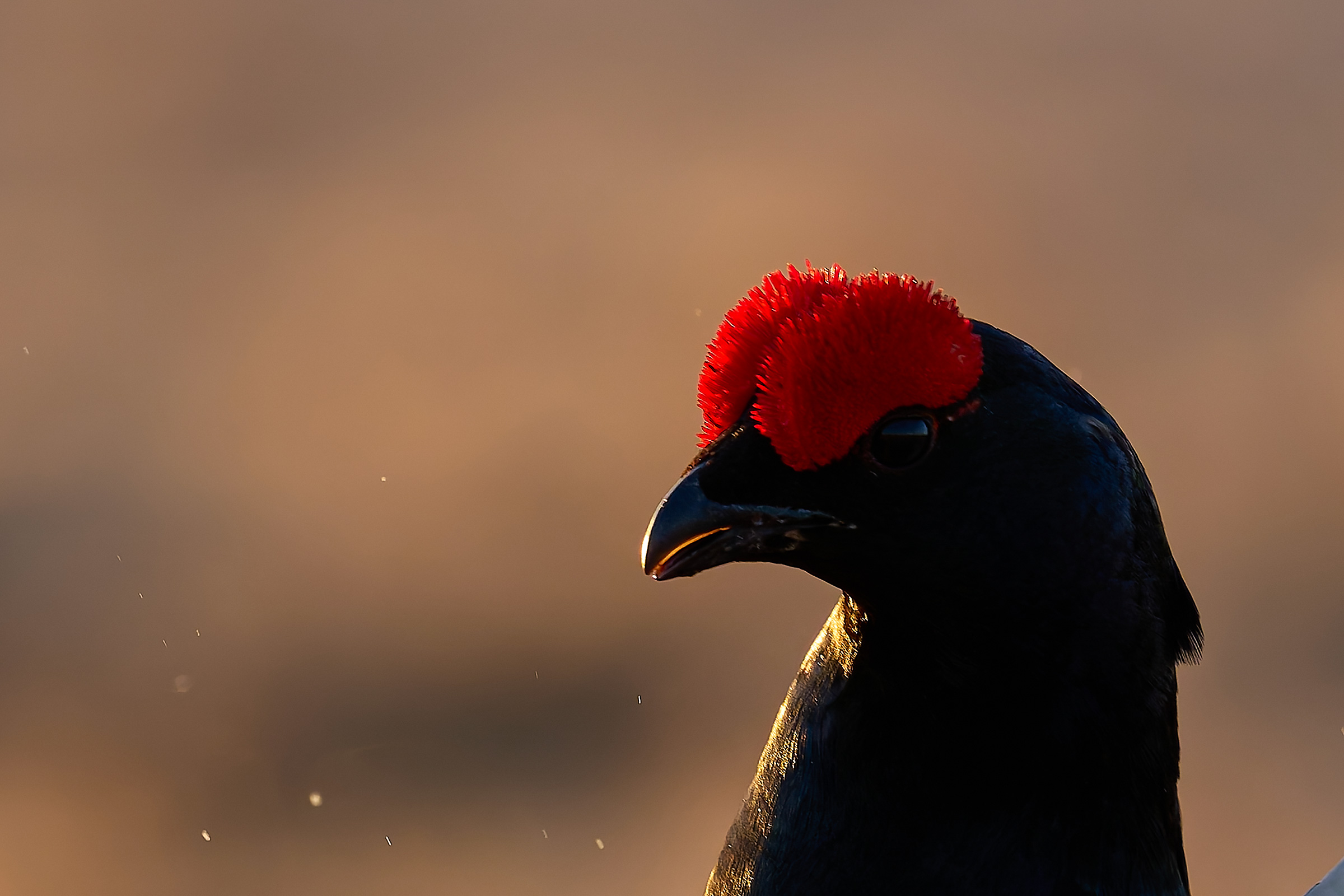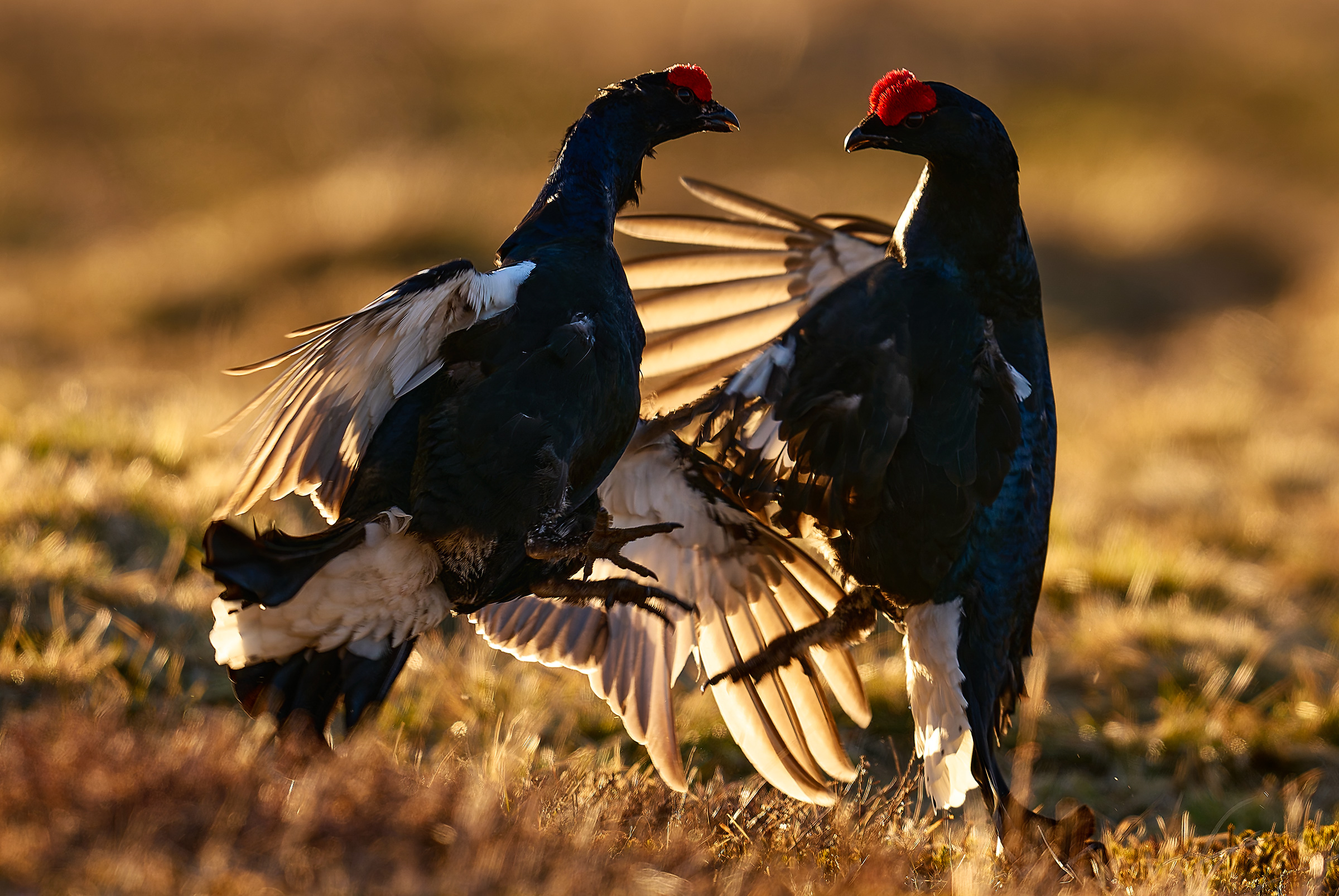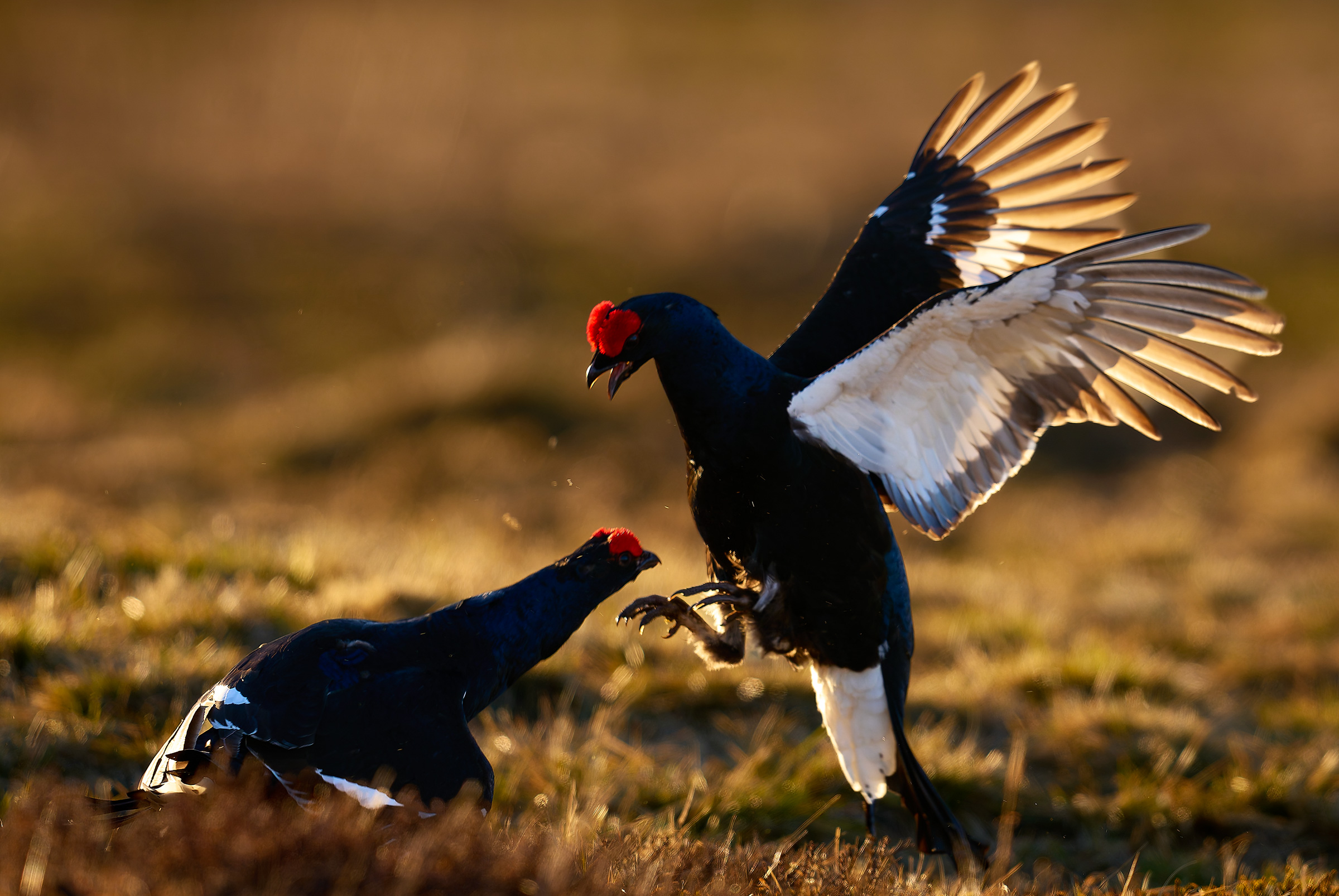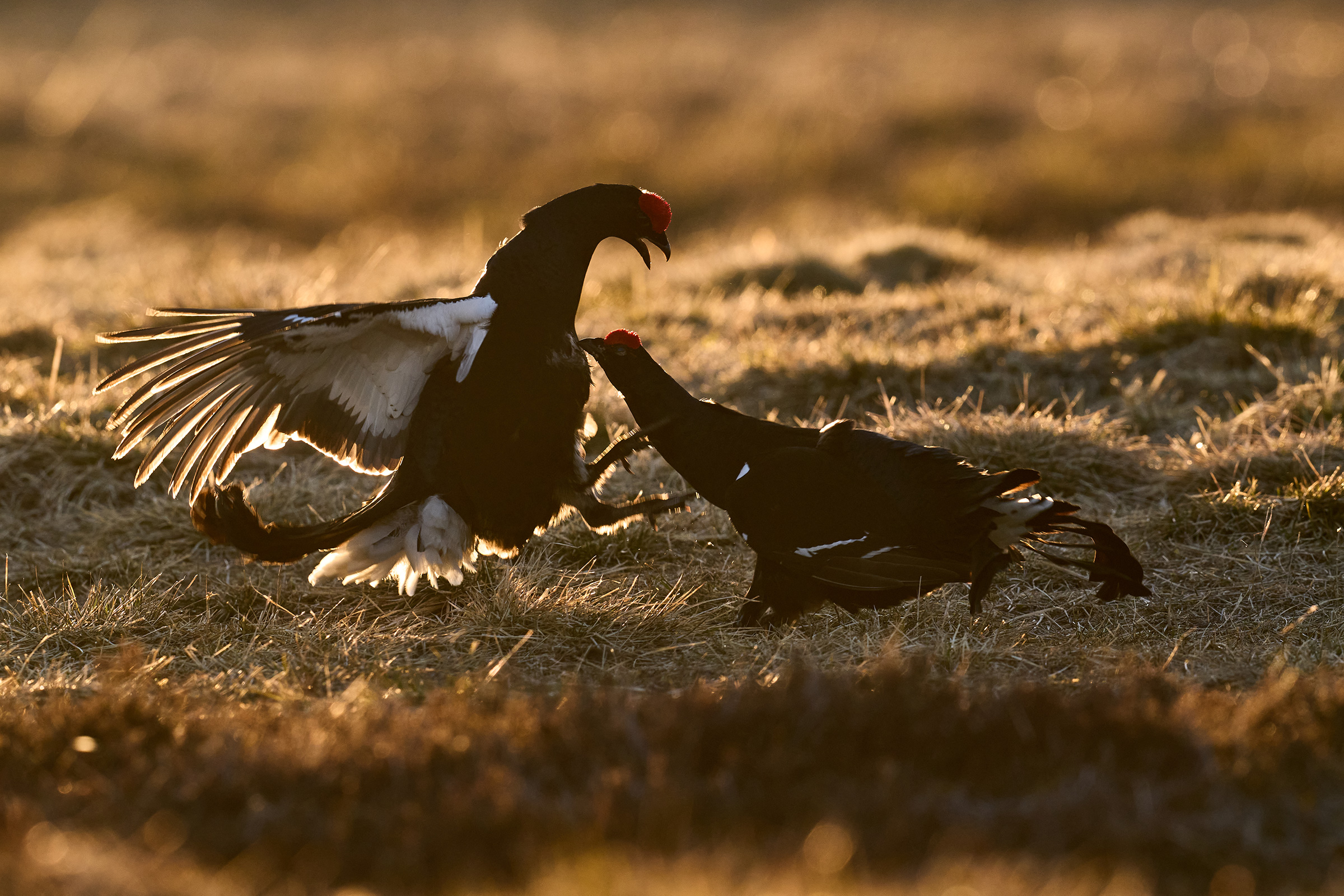I think birds are special. With their vibrant coloured plumage and wonderful displays they are exceptionally photogenic, and as a photographer, I sometimes think we really don’t spend enough time focused on capturing images of the interactions between birds. I recently asked a friend why he thought that birds were so beautiful compared to mammals and he answered – because mammals evolved to be primarily nocturnal and hidden, whereas birds have evolved to be diurnal and visible. If, like me, you crave photographs of interactions as opposed to just simple portraits, then look no further than the Black grouse (Lyrurs tetrix), a species with many interactions where you can sit in a hide and watch sex and violence, without a TV.

I am going to declare myself a grouse lover. As a scientist, I worked on the population biology of red grouse for more than 15 years and I have always been fascinated by the displays and behaviour of all the grouse species. Nothing quite compares to getting out of bed at 3am, putting on excessive amounts of socks and layers of clothes, grabbing a flask of coffee and heading out into the cold dark of pre-dawn and then creeping along the slippery wet gutters to slip noiselessly into a hide in the crispy cold dawn. Even though it is still dark, and you can’t see anything, you can hear the birds are present, the black grouse have already started their bubbling roo-kooing call which to the uninitiated sounds dove-like but continuous, and loud and can be heard 3km away. These calls are interspersed by a hissing “Tischu-wee” call that my friend Matt Ridley refers to, in his excellent book Birds Sex and Beauty1, as the opening of a can of lager – but much louder.

As you settle down for the long watch and slowly and gently make sure your camera is in place ready for the first shots at dawn, you hear the wing beats of birds flying into the lek, often close to your hide and this is followed by more roo-kooing. Slowly as the light improves you see through your camera the outline of the birds as the male grouse are calling and running around, checking out to see if anyone died during the night. You feel as though you are in the very midst of the morning parade, almost a voyeur since just in front of you is one of the great spectacles of nature that has gone on for centuries – males looking for matings and females looking for the fathers of their offspring. It doesn’t get much better than this.

There are two views on how the lek operates – the first is that males compete amongst themselves and the male that wins all the fights is the hot shot male, who then gets all the subsequent matings. This is much like a medieval tournament when knights jousted for the hand of the lady, a trial by male strength and the female was happy to be presented with the champion, knowing that he is the best male around. The alternative view is that this is not truly about male competition but female choice and so she walks around the lek and assesses the prowess dancing and displaying of the males, often nonchalantly picking at a grass seed or looking around for predators. In Black grouse the female only mates once a year, something that happens in just seconds after which she stores the sperm and leaves the lek not to return. She goes off and builds a nest in some quite location and uses the store of sperm to fertilize the 6-10 eggs she lays every day to day-and-a-half before settling down on them to incubate them for 22 days. She comes off only for a drink and a little feeding but when the chicks hatch lads them away to a good bog flush rich in insect life that the chicks need to grow. The chicks never see their dad – he was a two second wonder.

Is the female selecting the male because he holds the central location on the lek? Is this more akin to the hot spot in the disco, where the best male dancer gets into the spotlight to strut away so all the females can swoon and see what a gorgeous male he is? This isn’t really the case; the females may select one male one day and another the next day, even though they defend their own display arena every day. Interestingly, on any one day the females appear to copy the behaviour of the other females so if one female mates with a male, the others line up to mate with the same male. It is almost as if they appear to say “well if he’s good enough for you he’ll do for me”.

Biologists have spent years trying to work out what it is that makes the female choose a certain male. Is it his wonderful long tail? His shapely plumes? His red comb or his dance or maybe his call? Or is it simply the male that has been around the longest? As far as I can see from all the detailed work that has been undertaken, there is no simple characteristic – she uses many signals from the male including his call, dance, size and his strength.

While every female can get a mating, the statistics for the males are tough. Most males never get a mating and when they do, then they usually have one good year with multiple matings and then he dies before the next season. Probably the job of fighting off rivals, with little time to feed and recoup energy between sessions, means they are totally exhausted by the end of the season. Detailed studies in Finland lead us to suppose that it is the older males that tend to do well and these are the guys that are bigger, have the longer tails, spend longer at the leks and spend more time fighting, but they are also better at fighting off infections and avoiding predators so they are the successful and fit males. If you are a female and want your sons to be tough and attractive to the next generation of females- then it seems only obvious to select males with many good characteristics and not just the handsome male with a single good characteristic and not much good at anything else.

We owe so much to Charles Darwin for his deep and thoughtful analysis of variation in organisms and how natural selection then results in the evolution of beneficial traits. While his famous work was on the traits that are good for survival of the fittest, he was really fascinated by what he called sexual selection, the selection of characteristics that females found attractive for sex as opposed to survival. While there has been endless discussion about sexual selection in the scientific literature, I tend to think sexual selection as a component of natural selection and the flow of successful genes from one generation to the next. Selection of elaborate secondary sexual characteristics like the peacock tail are part of this and females would not choose a male that does not have these features but she wants more than just a handsome face.

One interesting concept in evolutionary biology is the runaway effect. That is when selection is all in one direction and can occurs even when there is an increasing cost to survival. Females need to produce both daughters and sons and the sons must be attractive to the next generation of females so they select the male with the slightly longer tail because he will be attractive to females – like a super stimulus – and then the subsequent generation will select for the slightly longer tail. And so on, so in just a few generations there has been strong selection for the tail of the males to get longer and longer, even when it makes them vulnerable to predation. This idea is backed up with the mathematics of genetics and shows that runaway selection by females of male features worked and indeed worked fast. Even when there was quite a strong cost – in terms of survival – to the males having a long tail we can expect the tails to get longer since the male with the longest tail gets all the matings, even if he dies soon afterwards, so his genes go through to the next generation and the females look for males with even longer tails.

Black grouse lek in open boggy areas and to attract many females the leks need many males, so black grouse need large areas of good habitat that supports chick rearing and adult survival. Sadly, the black grouse population, like most of the lekking grouse species, has been shrinking and populations are often just 10% of their original size. However, this is variable so that some populations maybe doing well while others are declining.

There are two primary reasons for the decline in Black grouse and the first is habitat loss coupled with agricultural improvements and the introduction of fences and perching places that favour predatory birds. Logging and opening areas can favour grouse in the short term but commercial monocultures soon close off the habitat to the black grouse. Increased cultivation, afforestation of heathlands, removal of birch stands are all negative effects. In some locations excessive hunting, disturbance at leks and factors such as collisions with high-tension powerlines may kill significant numbers of birds. I do think the recovery of black grouse requires large scale land management in areas where black grouse are already lekking, which ensures there are plenty of areas with insect rich bogs for chicks to feed on as well as the winter foods. I also think that females and their nests need to be protected from predators such as foxes and crows and care must be taken to ensure there are not fence posts and perches that predatory birds can use to swoop down on lekking birds.

I feel strongly that naturalists and photographers must “do no harm” while they are studying and photographing animals. Birds that lek are highly susceptible to disturbance and you must arrive well before dawn and leave only after the birds have dispersed. In both Scotland and Northern England, I have turned up before dawn in a car and then watched them from a distance, the car acting as a moveable hide but this is rarely good for photography. Obtaining permission and setting up hides on private land is a long-drawn-out process and I don’t approve of popping up a hide halfway through the mating season but spending months slowly moving hides into a good location with the landowners blessing.

More recently several companies have made arrangements for photographers to go and use hides on private land and these are often comfortable and very well located hides that capture the light and birds, in an attractive setting. Some hides are luxurious. The photographs I have taken here were all taken from the hides arranged by Finnature in their hides east of Oulou in Finland (https://finnature.fi/fi/). I found Finnature very good to work with, the people are charming, the instructions clear and the hides and birds just fantastic. They provided advice about where to stay close to the hides and what else was available nearby and always available and helpful. I can’t rate them high enough.

Black grouse are not the only bird with fantastic spring displays. Capercaillie, sage grouse, ruff, manakins as well as birds of paradise are all outstanding subjects. Maybe we will have a magazine devoted to their behaviour in the future.

1 I must say that if you have any interest in Black grouse biology and the wonders of lekking species you must read the outstanding book by Matt Ridley “Birds, Sex and Beauty. The extraordinary implications of Charles Darwin’s strangest idea” Published by Harper 2025.














